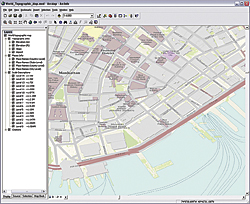ArcUser Online
Creating Authoritative Online Maps
This article as a PDF.
The demand for high-quality basemaps that can be used for GIS projects and Web applications has steadily increased. However, it is often difficult to locate basemaps that have the level of detail required and cover the area of interest. GIS departments compile and maintain mapping data for their own jurisdictions, but adding this data to a repository of basemaps for use outside the organization presents challenges.
The Esri Community Maps Program provides tools and templates for authoring and caching maps that make it easier for organizations that use GIS and providers of geographic data to contribute authoritative content to online community maps.
Contributing geographic data through the Community Maps Program benefits user organizations by decreasing costs associated with setting up and maintaining data and providing a mechanism for making high-quality, authoritative content available globally.
Data provided through the program is checked to ensure that it improves on the existing data in the community map. Esri requests permission to publish the data online as part of the community map, but does not take ownership of the data. Content that has been contributed and has been accepted is integrated into one of the existing community basemaps and published during the update cycle, typically twice a year.
What type of data is needed? Detailed basemap data for cities or regions at 1:5,000 scale (e.g., vegetation layers, building footprint data, parcel data), basemap data for counties or regions at 1:50,000 scale, detailed street network data at 1:50,000 scale or larger, and high-resolution imagery (i.e., 1 meter or better) that was collected in the past three years.
Many organizations worldwide have provided authoritative, current content to community maps such as the World Topographic Map, the World Street Map, and World Imagery. These popular maps are hosted and maintained by Esri and can be used with ArcGIS Desktop, ArcGIS Explorer, any ArcGIS Server Web mapping application, or in a standard Internet browser. The goal for all these community maps is making the best available data from multiple government and commercial data providers available to the user community.
Organizations interested in helping prepare data for online publication can perform two important tasks: authoring high-quality maps and caching these maps. Esri has created a number of downloadable map templates that ensure uniform, high-quality cartography. These templates also include map documents, sample data, and symbol style files. [For more information on using map templates to improve cartographic quality, see "Superior Results in a Fraction of the Time: Map templates enhance productivity and skills."]
Once the map has been authored, a map cache is generated using the Bing Maps/Google Maps tiling scheme. ArcGIS Server can be used to create a map cache using the built-in tiling scheme. Alternatively, Esri can create the map cache based on the authored map provided by the organization. The map cache is then blended into the appropriate existing community map and published for consumption.
Participation is simple. User organizations that are interested in contributing their data to the Community Maps Program just need to fill out a participation form and provide some information about their data, such as coverage area, resolution or scale, and a brief description. Once Esri has received the data, it will review it to confirm its suitability and notify the user organization. To get more details about the program, visit www.esri.com/communitymaps to fill out the participation form and download map templates.
The World Topographic Map contains city-level detail supplied by local governments such as New York City data from 1:9,000 to 1:1,000 scale contributed by the New York City Data Mine and several New York city agencies, including the Department of City Planning, Department of Information Technology, Department of Parks, Landmarks Preservation Commission, and New York City Economic Development Corporation, and data from the University of Virginia Library.
